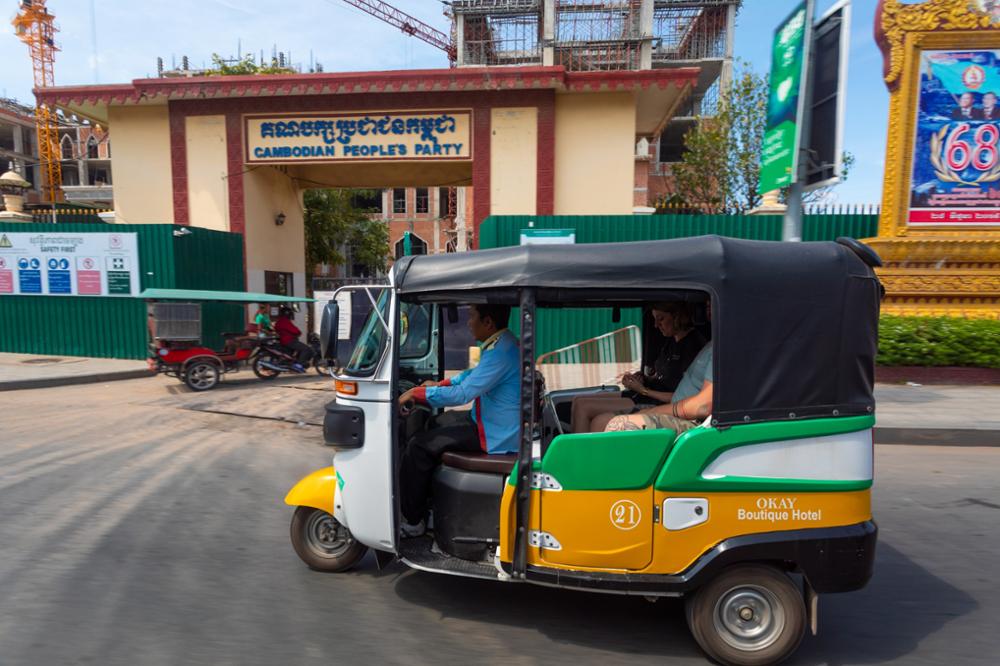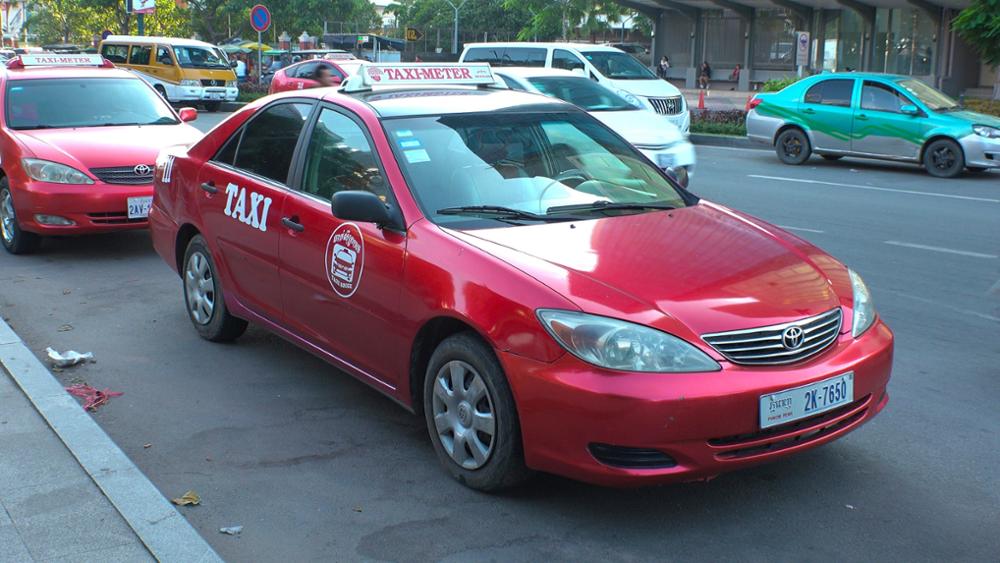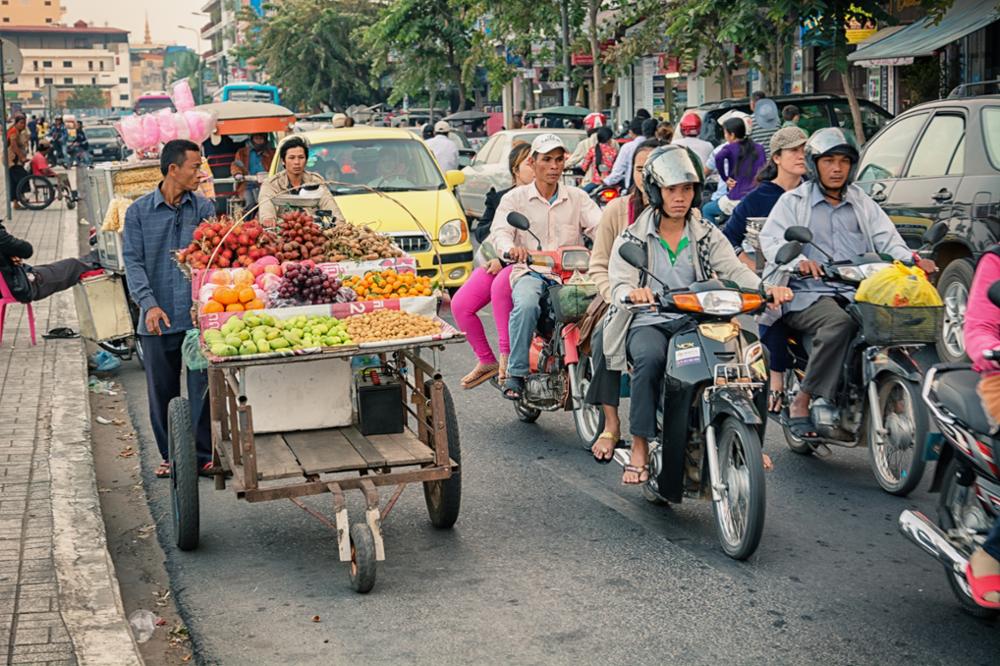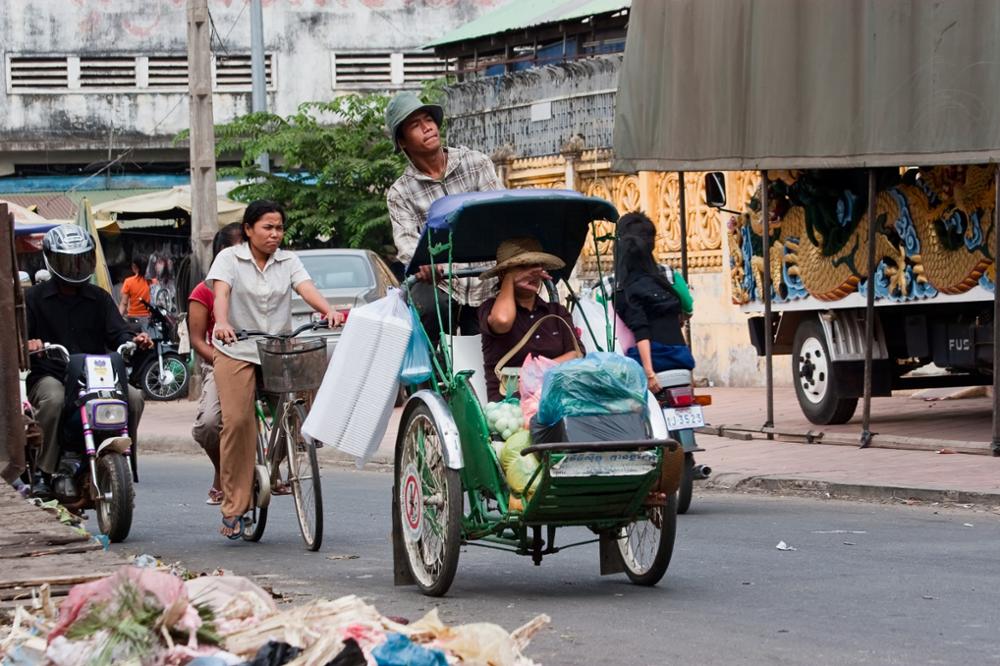
5 ways to get around Phnom Penh!
Walking around the Cambodian capital is an essential experience. Whether you’re visiting this rapidly growing city, traveling between different activity spots, or simply enjoying moving around in vehicles that don’t exist in France, you’ll want to get used to the local traffic habits. Don’t be too surprised by the differences you’ll encounter when you arrive compared to France. There is a traffic code, but driving is largely "by feel." This is even more the case in the provinces than in Phnom Penh. However, you’ll notice this right away at your first intersection in the kingdom. But don’t worry, drivers generally go quite slowly, especially during the day.
During your stay in Cambodia’s capital, several transportation options will be available to you. Each comes with its own pros and cons, often related to price or safety, but not only that. Here is a guide covering five different modes of transport to help you see more clearly before your arrival.
Before we start, know that for the first three options listed below, it’s advisable to check out one of our previous articles about ride-hailing apps like "Uber" available in Cambodia. These apps are very convenient as they allow you to track the driver on a map and standardize pricing. In other words, no more scams! In Phnom Penh, the app offers rides in rickshaws, traditional tuk-tuks, or taxis.
Rickshaw : The new trend
- Advantages: Commonly called the "yogurt pot," this small vehicle from India, which can carry up to three passengers behind a motorcyclist, is now the most common on Cambodian ride-hailing apps. It will take you no more than 2 or 3 minutes to find a driver, no matter where you are in the capital. The rides are just as fast, if not faster, than a traditional tuk-tuk or car, given the generally slow driving in the city. But the main advantage is undoubtedly the extremely low cost! For example, it will only cost you 3 USD to get to downtown Phnom Penh from the airport, whereas it would have cost at least 10 USD by tuk-tuk before the arrival of these ride-hailing apps.

Disadvantages: Honestly, there are very few disadvantages to taking a rickshaw over other modes of transport. It can be a bit warmer than a tuk-tuk due to its almost enclosed outer frame, but many rickshaws are equipped with a central fan. The real drawback is that, due to its light frame and minimal weight, the rickshaw offers little protection in case of an accident. Moreover, the small size of the vehicle may encourage some drivers to take unnecessary risks. Finally, the rickshaw isn’t suitable for large families, but it’s possible to order multiple rickshaws!
Personal Opinion: In my view, it’s the safest bet on the market. There will always be a rickshaw available for you at any time, and for a very low price!
Tuk-Tuk : Still standing
- Advantages: Despite the arrival of its younger sibling, the rickshaw, in 2017, the traditional tuk-tuk still populates the streets of Phnom Penh, looking for travelers seeking authenticity. This is, of course, its biggest advantage. The "trailer" pulled by a motorcyclist is equipped with two comfortable benches facing each other. This is Southeast Asia; the Cambodia you see in photos! A canopy, resembling the roof of a small pergola, shelters passengers from the sun. Along with the two side panels protecting the rear seat, these are the vehicle's only true enclosures. The air is particularly fresh and caresses the passengers' faces, who can easily admire the capital.

Disadvantages: The ride in a tuk-tuk will always be more expensive than a rickshaw or a motodop. This disadvantage used to be much greater, as drivers would demand exorbitant sums, taking advantage of tourists who were usually unaware of the average prices. But that era is over since the arrival of the ride-hailing apps. Due to its larger size, the tuk-tuk is also less mobile than the rickshaw or motorcycle, which can sometimes lengthen the travel time, especially during rush hours. Most tuk-tuks have zippered protections to shield passengers from the rain, but if yours doesn't and a downpour occurs, you’ll end up soaked… This disadvantage also applies to motodops and cyclos.
Personal Opinion: We often take the traditional tuk-tuk when there are more than three people. It’s a convivial moment, after all.
Taxi : In comfort
- Advantages: Many taxis roam the roads of Phnom Penh. They have the advantage of offering air conditioning! It’s hot year-round in Cambodia, even during the monsoon season between July and October. Only December is spared, with temperatures dropping to around 20°C for a week. Air conditioning is a feature sought after by many travelers who fear the intense heat. Moreover, the safety provided by the car is significant compared to other modes of transport. For those interested, it’s possible to choose a sport utility vehicle (SUV) in the app, though the fare is more expensive.

Disadvantages: Taxi rides are naturally more subject to traffic jams in the capital, whereas motorcycle, rickshaw, and even tuk-tuk drivers can always find a way to reduce their travel time. But the most important drawback is that a taxi obviously lacks the authenticity that many travelers are looking for. Those expecting something new, something to break the daily routine, will certainly not find that sitting in an air-conditioned sedan.
Personal Opinion: I’ve never ordered a taxi in Phnom Penh, and I’ve only ridden in an SUV once, where the driver tried, unsuccessfully, to increase the fare shown in the app. I would avoid it.
Motodop: A flash of speed
- Advantages: Let’s now discuss modes of transport not featured on Cambodia’s ride-hailing apps. The motodops, or motorbike taxis, fall into this category. But don’t worry, they are everywhere around many Phnom Penh intersections. Motodop drivers are usually easy to spot; there are often several of them waiting in the same spot, each with the same bike, a black Honda Dream, which is an extremely popular model in Cambodia. Although they are not part of the digital platforms, motorbike rides are still quite affordable. They’re sometimes even cheaper than a rickshaw. But the main advantage of the motorbike is, of course, the travel time. Motorcyclists can easily maneuver through traffic, slowly but efficiently, making it undoubtedly the fastest way to get around Phnom Penh.

Disadvantages: It’s no secret that motorcyclists in Cambodia, and more generally in Southeast Asia, are the most vulnerable on the roads. Running red lights, changing lanes without checking the mirrors or signaling, and SUV drivers who only care about themselves are all factors that make it dangerous for bikers. It’s essential to ask the driver to provide you with a helmet for the ride. They often have one, but not always. Be sure to ask them before getting on the bike and use the phrase "mou sovatopheap?" which literally translates to "safety helmet?" Finally, motodops are obviously only for those traveling alone.
Personal Opinion: This is by far the mode of transport I’ve used the most since arriving in Phnom Penh two years ago. It’s fast, efficient, and I’ve never had an accident. I highly recommend it for those traveling alone.
Cyclo : Old-school style
- Advantages: The cyclo driver sits on an elevated bicycle seat, positioned behind the spacious passenger seat. Among all the modes of transport listed above, the cyclo is the oldest. Its use dates back to the French Protectorate (1863–1953). The French nationals of the time invented the name, which is still used in Khmer today. Today, the main advantage of the cyclo is its eco-friendly nature. In a capital often polluted by vehicle fumes, the cyclo is Mr. Ecology, as it is powered by a cyclist. It also evokes nostalgia for older generations or those passionate about the era, reminiscent of early 20th-century Cambodia.

Disadvantages: The cyclo is, without a doubt, subject to controversy despite its eco-friendliness. The term "protectorate" is still a sensitive issue for many Westerners, though many Cambodian families have fond memories of that time. Still, using these vehicles in the city may be seen as a reminder of colonialism. Another negative aspect comes from the sympathy felt for the cyclo drivers. Often quite old and wearing a head covering, they sometimes have to cover long distances while pulling passengers under the scorching sun. Some people feel sorry for them and believe they should stop burdening themselves with such tasks, while others advocate using this mode of transport to help these drivers earn a living. It’s up to you to form your own opinion. In any case, if you wish to engage with a cyclo driver, you will mostly find them in the city center. The cyclo is clearly the least common vehicle among those listed here.
Personal Opinion: I’ve never had the chance to ride in a cyclo. However, the societal debate surrounding it is fascinating.
There are many other ways to get around Phnom Penh, such as renting bicycles, scooters, motorcycles, or cars, or using public transportation: Phnom Penh buses. Unfortunately, these are still too few in number to be attractive to travelers and struggle to compete with the modes mentioned above. But they have the merit of existing, and nothing stops you from hopping on one for a ridiculously low price and crossing the city.
